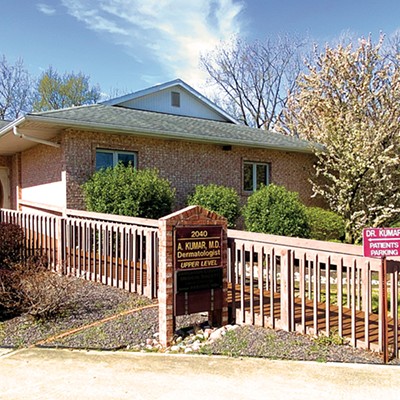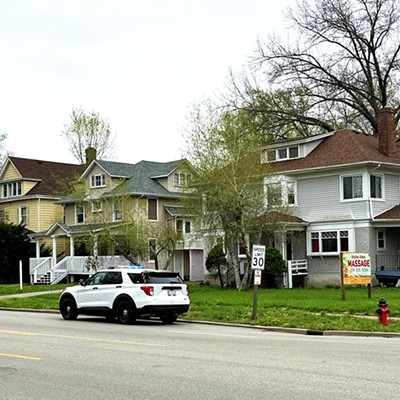In August, the Springfield Muni Opera will stage West
Side Story. Directed and choreographed by Anna Bussing, the Broadway classic will
play August 7-8, 13-15 and 20-22. (Curtain
at 8:00 p.m.)
Muni put on West Side Story in 1977, and I was backstage on opening night in my disguise as a reporter. It was a pleasurable assignment, in spite of Illinois’ August weather, and I met many lovely people, only a few of whom, unfortunately, are named in the text.
Also unfortunate is the fact that we
cannot reproduce the photographs by our Jesse Ewing that illustrated the story.
So. . . curtain up!
An hour before curtain. Backstage is already filled with people. The stage itself lies athwart the bottom of the Muni Opera hollow, its superstructure painted black, a square-rigger stranded on the hillside.
Behind it is a small square. On to the east are two dressing rooms, painted bright red; to the west stands a scenery shop. In between there's a patch of grass. Farther away, hugging the edges of the compound, are rest rooms (marked "Guys" and "Dolls") and the mobile home belonging to the resident caretaker.
The director strolls among the cast and crew. He's Thayne Erney, a counselor at Springfield High, a Muni and Theater Guild regular. He's drinking Dr. Pepper from a can. He's worked on the show four or five hours a day, sometimes for as many as seven days a week for the last eight or nine weeks. A few years ago, a Muni member calculated that a typical Muni director spends nearly 500 hours getting a play in shape. His job is finished now. He says everything is ready, that the show is good. He does not look nervous, but he rarely stands in one place for long.
Erney scans the bustle backstage. People constantly come up to him, congratulate him, ask him questions, complain. He shows a visitor around the set, including Muni's newest addition, a $21,000 costume and props building that was paid for in part with a $10,000 chunk of Mayor William Telford's share of the city's community development funds. In 1953, when the Muni needed a backstage building, it bought a twenty-eight-year-old railroad boxcar, took the wheels off and parked it behind the stage.
On the surface this opening night is not much different from the forty-two other opening nights at Muni since the group's reorganization in 1965. But tonight there's a determination that's unusual. West Side Story, the updated Romeo and Juliet tale about gang rivalry and love in New York, is a difficult show to do—hard to play, hard to dance, hard to stage.
For the better part of two decades Muni has shied away from Story, afraid to risk embarrassing themselves. There are people who think the show is still beyond the reach of a small-town company, even a talented one like the Muni. Erney and the roughly 100 people who've worked on West Side Story want badly to prove them wrong.
Some of the players are venting opening-night nerves in talk—talk that comes in short, fast bursts and bounces from one subject to another.
"I just lost a false eyelash!"
"Did you see the Tonight Show last night? Charles Nelson Reilly gave us a plus last night. Really! He said Naughty Marietta was good, but West Side Story was safe."
"I think I'll do it without a shirt."
"If you do, you'll have to make up your whole body."
The stage itself looms over a broad concrete apron that separates the stage from the grassy patch behind it. A makeup table perhaps twenty feet long runs the length of the stage's backside. It is lighted with a single row of tightly spaced light bulbs. Every seat at the table is occupied, so latecomers have to bend down over the shoulders of those already seated to see into the mirror. Eyebrows are touched up; hair is sprayed. The damp evening air quickly takes the starch out of the finely sculpted 50s-style hairdos sported by the Jets gang members; the Sharks' hair is greased back and is impervious to weather. They comb it constantly. Nerves, maybe. Or an unconscious manifestation of character.
Half an hour till curtain. Dancers silently practice steps, spinning down the walks connecting the backstage buildings, softly counting off cadences to themselves. Others study lines.
Jane Kahn, stage manager, leans over the railing that keeps careless troupers from falling off the stage onto the apron below. "People," she calls, "according to the sign-in sheet some of you aren't here." She calls roll. "Alice Havey...Marcia Heroux...Mary Jamison...Bobbi McKinney..." Everybody's there. No one, including Kahn, expected them not to be.
A Shark wanders nervously. His caramel-colored makeup only partially hides a case of acne. Like the rest of his gang, he wears a black jacket made of cotton rather than leather—a happy adjustment to the original costuming, considering the muggy heat of Illinois Julys—emblazoned with a bright orange "S" on his back. He munches popcorn and speaks to no one.
The Jets are the white gang. They wear white jackets. Many are blond. Their hair, though combed in an approximation of 50s punk, is not greased down; Tony, the ex-Jet hero, sports an unmistakably 70s-style razor cut. The Sharks, the Jet's Puerto Rican antagonists, are dark-haired, punkier, dressed in black—distinctions that border on racism. One doesn't need a program to tell the heroes from the villains. Backstage, curiously, the Sharks and the Jets rarely mix, sticking with fellow gang members.
"Fifteen minutes to vocal warmup."
Roberta Volkman is the vocal director. She's a music teacher for District 186. Like most of the production staff, she will spend the evening out front watching the show with the rest of the audience. This is her third Muni show. It is, she admits, the first time she's felt nervous. "Everybody said we couldn't do it," she says. It is a phrase heard again and again backstage. "My obstetrician—even he asked, 'Do you really think you can do it?' while he was examining me. I mean, after that, we just had to do it to prove ourselves."
There is enough hairspray in the air backstage to attract flying insects, hundreds of them. They swarm crazily, white in the light, like windblown snow.
After the "Dance at the Gym" number, Brian Pier, "Diesel," talks. He's done several Muni productions, including one stint as set designer for Bye Bye Birdie. Like just about everybody in the cast, he's wanted to do Story for a long time. The father of somebody in the cast made a videotape of a rehearsal and it's scheduled to be shown in a couple of days, so the cast can see what they look like onstage. Pier is looking forward to it. "We'll be on a TV show, you know," he says, drawing a TV screen in the air with his hands.
On the benches backstage, people talk.
"I could use a bottle of wine right now."
"She's really 'Maria.' isn't she? Offstage, too. So shy."
"The gym dance was aborted. That really steams me. What are those guys getting paid for? After nine weeks they won't do what we want them to do."
"It's going pretty good, I think."
One of the girl dancers chats for a moment. She's already changed for the ballet that opens Act II; until then she has nothing to do. She's wearing leggings to keep her legs warm. She doesn't have an important role, she says, sounding disappointed, though "I helped paint the graffiti on the scenery. Did you see the 'Class of '58' up there? I did that." The conversation takes the inevitable turn. "Everybody said we couldn't do it—the people at Muni, the audiences. People don't know what kind of talent there is in Springfield. In the arts, I mean."
Intermission. Twenty minutes.
The backstage area fills with people—Muni officials, well-wishers, fans, relatives of the players. "Tony" signs autographs for a couple of girls. A Shark passes through the crowd in hot pursuit—Act I finishes with the frenetic "Rumble" and it's still muggy out—of a lemon shake-up; as he passes people he says "Excuse me" in a Puerto Rican accent. The word backstage is that the show is playing well.
Act II starts. Back at her bench, Anybodys sits with Robert Levine, whose character, the Shark leader Bernardo, died at the end of the first act. Anybodys gives a small salute when the sound comes up signaling the start of Act II, then looks at Levine. "Wadda you care? You're dead." Levine says nothing. He's playing a recorder. When the loudspeakers plays 'I Feel Pretty," he plays along. Nearby, David Shipley who plays the Jet "A-rab," mimics the number being played out front. His partner is a blond girl, noncast. He dances, she sits, silently mouthing the words coming over the speaker—"I feel pretty and witty and gay"—singing into a fragment of mirror Arab borrowed from the now-vacant makeup table. She frames her upturned face with her hands. He compliments her with a bow. They laugh.
The second act goes smoothly. It's much shorter than the first. "Officer Krupke" earns cheers from the audience, something that gives some of the players an almost giggly pleasure. As the end comes closer there are fewer and fewer things that can go wrong and tension is easing rapidly. There are hugs and handshakes backstage. Everyone smiles. Onstage, a duet between Maria and Anita, Bernardo's girlfriend goes well, the taunting scene in Doc's drugstore passes without mishap, as do the climactic shooting scene—the blank gun fired to everyone's relief, the last potential mechanical miscue—and finale in which Tony's body is carried offstage by members of the temporarily reconciled gangs. A short chorus of "Somewhere," a bow and it's over.
At the end the applause is loud. A few cast members peek out front, and word of what they see spreads through the backstage like a fresh wind. "They stood up! Standing ovation!" Players run down the ramp offstage with the news. A few of them start clapping, for the audience. The reviewer from the Journal-Register will say that the demands of the play were "admirably met," something that the audience, talking with the cast over punch and cookies at the traditional first nighters' party, will soon also tell them. But the cast and crew, though grateful for the compliments, don't need anyone to tell them what they now, after nine weeks, finally knew for certain—that they'd done the show and they'd done it well and everybody knew it.
The (big) business of running Muni
The Springfield Municipal Opera Association is big business. Since 1965, the not-for-profit corporation has staged musical plays at a fifty-five-acre site near Lake Springfield. Since it gave birth to its first production—"Music Man" —the company has produced forty-two plays, sung and danced for thousands of central Illinois theater fans and established itself as one of the area's most popular and accomplished amateur theatrical companies.
The success of the present Muni is the more remarkable because summer musical theater is an idea that has been tried before in Springfield and failed. In the 1950s the original Municipal Opera staged several operettas at the lakeside site. But the group attempted—unwisely as it turned out—to pay its performers. The company went into the red. in one year losing more than $30,000. By 1956 the Muni was "not dead, but dormant," as one press account phrased it.
Muni's lease with the city was due to expire in 1965, when the theater site would revert to the city. Hoping to forestall that loss, local theater people in the summer of 1964 decided to give Muni another try. A fund goal of $25,000 was set—the amount, they guessed, it would take to fix up the now-weedy and dilapidated theater—and plans made for a production of "Bye Bye Birdie" to be presented at the Douglas Park bandshell. The show was a hit, and the next season found the Muni reinstalled at its lakeside home.
Since then Muni has grown into what is perhaps the largest amateur theatrical group in the state. The 1965 season saw two plays produced; by 1967 they were ready to stage three per summer and. by 1972. four. Unlike its predecessor, Muni pays no one except a handful of union musicians and electricians. All proceeds go into the production; acting, directing, sets, costumes, makeup, ticket sales, site maintenance—all these jobs are done by volunteers, either members of Muni or cooperating community groups.
Audience response has been good. As many as 6000 people have paid to see a Muni production ("Fiddler on the Roof" in 1971), and one night more than 1300 crowded in to see a single performance. Even using volunteer help, the budget for a four-production Muni season runs to $70,000. The group is managed by an eight-member board which is assisted by a twenty-six member Board of Managers. If past seasons are any guide, by the time the 1977 season closes with "My Fair Lady" in August, an estimated 500 persons will have contributed in some way to the Muni.
The growth of Muni is reflected in its physical expansion. In addition to the stage, the group boasts a $20,000 lighting system, a new $21,000 costumes-and-props building, a ticket/refreshment building (which replaced a rented tent), plus dressing rooms, a scenery shop and more.
—J.K.Jr.

















